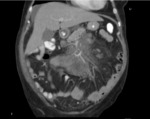Learning objectives
Make a conceptual review of mesenteric panniculitis.
To demonstrate the imaging relationship between the different diagnostic imaging methods for the identification of mesenteric panniculitis,
scope,
and limits.
Identify pathologies associated with mesenteric panniculitis,
which generate difficulty when establishing the diagnosis.
Background
Mesenteric panniculitis (PM), also called sclerosing mesenteritis,
belongs to a spectrum of rare diseases of the fatty (adipose) tissue of the mesentery. PM is characterized by fatty degeneration and necrosis,
chronic inflammation and,
sometimes,
scarring and fibrosis of fatty tissue in the mesentery.
This inflammatory and sometimes progressive condition is more likely in the spectrum of autoimmune disorders(3).
PM was first described in the medical literature in 1924 as "retractilemesenteritis" (4).
Other alternative names have also been used to describe the condition.
These names denote...
Findings and procedure details
ETIOLOGY
Considering that a specific cause of the disease has not been objectively established,
the evidence establishes a strong relationship between panniculitis as an autoimmune disorder. In general,
genetic and environmental factors play a fundamental role in the development of autoimmune diseases (6).
Many factors support the hypothesis that PM is an autoimmune disease.
These include the fact that biopsies from the affected regions show chronic inflammation.
In addition,
systemic symptoms that are characteristic of other autoimmune diseases such as rheumatoid arthritis and Crohn's disease,...
Conclusion
PM is a rare,
benign and chronic fibrosing inflammatory disease that affects the adipose tissue of the small bowel mesentery and the colon,
it can occur in isolation or associated with other diseases.
The diagnosis of this inflammatory and nonspecific disease is a challengenot only for radiologists but also for gastroenterologists,
surgeons,
and pathologists.
Ultrasound is the first order method for diagnosis,
however,
Tomography is nowadays the best tool to characterize and rule out other pathologies.
Personal information
Contact Details :
Dr.
Gustavo Averanga
Resident in training.
Departament of Radiology.
Hospital of Trauma and Emergencies "Dr.
Federico Abete" Pablo Nogues,
Bueno Aires-Argentina.
Email:
[email protected]
Dra.
Zulmara Figueroa
Dra.
Grettel Leal
Residents in training.
Departament of Radiology.
Hospital of Trauma and Emergencies "Dr.
Federico Abete" Pablo Nogues,
Bueno Aires-Argentina.
Dra.
Paola Yuly Narváez
Chief of Residents.
Departament of Radiology,
Hospital of Trauma and Emergencies "Dr.
Federico Abete" Pablo Nogues,
Buenos Aires-Argentina
Dra.
Julieta Crosta
Chief ofthe Department of Ultrasonography.
Hospital of Trauma and Emergencies "Dr....
References
1.
Iyad Issa and Hassan Baydoun.
Mesenteric panniculitis: Various presentations and treatment regimens World J Gastroenterol.
2009 Aug 14; 15(30): 3827–3830.
2.
Emory TS,
Monihan JM,
Carr NJ,
Sobin LH.
Sclerosing mesenteritis,
mesenteric panniculitis,
and mesenteric lipodystrophy: a single entity?Am J Surg Pathol.1997;21:392–398. [PubMed].
3.
Ginsburg PM,
Ehrenpreis ED.Panniculitis mesentérica en: NORD Guía para trastornos raros.Lippincott Williams y Wilkins.Philadelphia,
PA.2003: 350.
4.
Jura SV.Mesenterile retrattile e sclerosante.Policlinica.1924;31: 575-581.
5.
Vettoretto N,
Diana DR,
Poiatti R,
Matteucci A,
Chioda C,
Giovanetti M.
Occasional finding of mesenteric...



